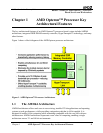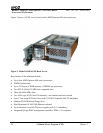
Builder’s Guide for AMD Opteron™ Processor-Based
Servers and Workstations
30925 Rev. 3.04 February 2004
10 AMD Opteron™ Processor Key Architectural Features
Chapter 1
Integrated DDR DRAM Memory Controller
The 128-bit wide integrated DDR DRAM memory controller:
• changes the way the processor accesses main memory, resulting in increased bandwidth,
reduced memory latencies, and increased processor performance.
• allows available memory bandwidth to scale with the number of processors.
• can support up to eight registered DDR DIMMs per processor.
• has available memory bandwidth of up to 5.3 Gbytes/s (with PC2700) per processor.
HyperTransport™ Technology
The HyperTransport technology of the AMD64 architecture offers the following features:
• A scalable bandwidth interconnection between processors, I/O subsystems, and other chipsets
• Support for up to three coherent HyperTransport links, providing up to 19.2 Gbytes/s of peak
bandwidth per processor
• Up to 6.4 Gbytes/s bandwidth per link providing sufficient bandwidth for supporting new
interconnects including PCI-X, DDR, InfiniBand, and 10G Ethernet
• Low power consumption (1.2 W) to help reduce the system thermal budget
Other Features of the AMD Opteron™ Processor
Other features of the AMD Opteron processor include:
• 64-bit wide key data and address paths that incorporate a 48-bit virtual address space and a
40-bit physical address space
• ECC (error correcting code) protection for L1 cache data, L2 cache data and tags, and DRAM
with hardware scrubbing of all ECC-protected arrays
• Lower thermal output levels and improved frequency scaling through .13 micron SOI (silicon-
on-insulator) process technology
• Support for all instructions necessary to be fully compatible with SSE2 technology
• Two additional pipeline stages (compared to AMD’s 32-bit architecture) for increased
performance and frequency scalability
• Higher IPC (instructions-per-clock) achieved through additional key features, such as larger
TLBs (translation lookaside buffer), flush filters, and enhanced branch prediction algorithms


















